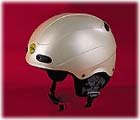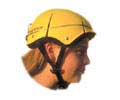
Gear Home SEE ALSO:
Marketplace
Contests
Auctions
Ski Resorts


|
Put a Lid On It
Head Injuries Don't Heal Well [Click here for the stats]
 Red Skycap | |
If you've ever spent a day learning a trick by repeatedly slamming the back of your head into the ice, you're probably aware that the beanie doesn't offer much padding. But the real benefit of a helmet comes when the unexpected occurs--a sudden collision with a tree branch, another snow slider, or a stump hidden beneath the snow. These are the events you can't prepare for. Most serious injuries (including deaths) that occur on a mountain are the result of someone bombing down from behind and colliding with the victim, who rarely knows what hit them. When you add in obstacles made of frozen pine, metal or granite, the ways to get your melon mushed increase dramatically. And unlike a knee or shoulder, serious head injuries don't heal.
|
|
|
|
|
|
|
|
| "The real benefit of a helmet comes when the unexpected occurs — a sudden collision with a tree branch, another snow slider, or a stump hidden beneath the snow. These are the events you can't prepare for..." |
|
|
|
|
|
|
|
|
But the real issue here is one of character. In the ongoing fashion show of lift lines and lodges, can you pull off the helmet? Will you be able to swap greetings with the same degree of swagger and self-assuredness that a beanie imbues? Can you mack on the java stand girl or work the grill guy for free curly fries while sporting a candy-coated head? The brain bucket is more than a safety device. It's a test of style.
 Boeri Carrera | |
Unlike a few years ago, a helmet no longer means "Dork." Helmet sales have increased 40% each year for the past two years. Much of this is because youth racing programs require participants to wear helmets. But the fastest-growing group of helmet buyers is adult skiers and snowboarders who take on a mountain's most extreme terrain. These are the Racer X's of winter, the Mad Bombers who venture into expert terrain. A helmet offers the added protection that lets you huck a new trick. It helps you focus on the chute and not the rocks that line it.
 Leedom Limit | |
Here's a quick list of some other things to look for when deciding how best to protect your brain.
Fit: Better than Gloves
The most important factor in choosing a helmet is fit. A lid won't protect you if you've got a high degree of head-slop. Your first step in choosing a helmet is to try on a lot of different models. Find ones that you can micro-adjust to fit the special lumps of your head. A good bet is the Team Wendy Ripley ($110). With a patent-pending shell compression adjustment system, the Ripley snugs down on about any adult head.
 Team Wendy Ripley Model | |
In gauging a helmet's fit, try to find one that fits your head (without beanie or goggles underneath) snugly enough so that your head and helmet move as one: Too tight and your face turns beet red, too loose and your helmet will move upon impact and be unable to absorb the impact the way it's designed to.
 Giro Ravine | |
The last think you want from a helmet is the feeling that you're wearing a plastic bag over your head. A quality ventilation system is key for keeping your noggin comfortable on both cold stormy days and in the Spring sunshine. The Giro Ravine ($125) which features Thermostat™ Vents that allow you to customize the amount of airflow the helmet allows, is a good example of a helmet designed to keep your head at the right temperature.
 Leki Freeride | |
Being able to hear makes being on the mountain much more enjoyable. The scrape of edges on ice, the calls of "Dude! Dude!" from above, the coquettish hollers from the chairlift — all reasons why a helmet should allow you to hear with a good degree of clarity. The Leki Free Ride ($120) and Briko Aggressive ($200) both feature cut-outs in the shell of the helmet that provide the ability to hear. The Leedom Limit ($110) and Red Skycap ($99) have permeable earflaps that will keep your jug handles warm while still allowing you to hear.
Both approaches offer different benefits: the fuller helmet will keep your head warmer and extends the protective shell down over the jaw, which is good for post-riding rasslin' matches. The fabric earflaps keep the helmet lighter, cooler, and give it more of that "you know you want it" Harley look.
Durability: Know Your Crash Limit
Companies are putting out helmets designed for single or multiple crashes. The single-impact helmets are constructed with materials that won't spring back in place after a crash, and need to be returned to the manufacturer after an impact. You should carefully inspect your single-impact helmet after it makes solid contact — once the shell has been cracked, it won't provide full protection. The good news is that many manufacturers offer crash cash, a discount on your next helmet purchase when you return the damaged item.
Multi-crash helmets can survive multiple headers, baggage handlers, and several games of dodge ball. They cost a bit more, but are worth it especially if you are clumsy or tend to lead with your head. Be sure though to always inspect your helmet before to going out for a ride. Even multi-crash helmets aren't invicible.
Smell: Funky Head is Bad
While not the most important safety feature, a removable, washable liner is something that's nice, especially after a Spring day or an afternoon spent hiking the pipe. Most helmets come with a synthetic liner that make your head smell like old socks if you can't wash or at least spot clean it. Make sure your lid is designed to remain sweet-smelling and fresh, or risk your friends pointing at you and saying, "Look at Stinky go!"
— Jim Humes, Mountain Zone Correspondent
|
|